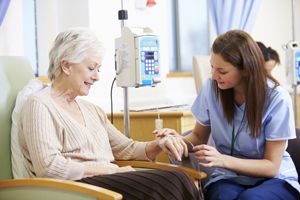Oncology Nurses Use Aromatherapy to Improve Patient Well-Being At Night
A single-arm study pilot study showed that patients' well-being scores significantly improved with the introduction of aromatherapy.
Oncology Nurses Use Aromatherapy to Improve Patient Well-Being At Night

Oncology nurses may be able to boost their patient’s well-being, and improve their sleep quality, through lavender aromatherapy, according to findings published in the Clinical Journal of Oncology Nursing.
Among a sample of 34 patients with cancer who had been hospitalized, the mean well-being scores improved significantly (P = .006) through aromatherapy, with a mean preintervention score of 46.38 and a mean postintervention score of 58.
Although patients reported that their mean quality of sleep improved, the difference was not statistically significant. Overall, the mean global Pittsburgh Sleep Quality Index (PSQI) score decreased from 9.38 to 8.45 (P = .123) with the intervention.
“Oncology nurses are in a key position to educate and encourage patients to manage nighttime discomfort and improve quality of life,” Leah Ann Phillips, BSN, RN, PHN, CHPN, a palliative care nurse at Providence Holy Cross Medical Center, and co-investigators wrote in the study. “This pilot study’s findings suggest that lavender aromatherapy is a safe, feasible, and potentially effective intervention for hospitalized patients receiving oncology care. These findings should increase awareness of the benefits of aromatherapy to improve nighttime comfort for this unique population.”
Previous studies have demonstrated that essential oils and aromatherapy can improve general well-being and sleep both within and beyond the realm of cancer care. Moreover, previous nurse-led studies have been successful in this area. Because of that, oncology nurses sought to determine whether they could improve their patient’s nighttime comfort, specifically their sleep quality and well-being scores, through aromatherapy.
The study was described to be “quasi-experimental.” Investigators used a single-arm design, with a pre-/post-test questionnaire to evaluate the effects on the intervention. To be eligible for participation, patients needed to be 18 years or older, speak English, be admitted to an inpatient oncology unit for at least 2 consecutive nights, and consent to the study. Patients with asthma, allergies to ragweed, olfactory deficits or sensitivities, cognitive disabilities, or any current or past respiratory conditions were not allowed to participate.
The principal investigator was responsible for the aromatherapy diffuser. The investigator would remove the top cover and add tap water into the reservoir up to the red maximum water level indicator, placing 8 drops of lavender essential oil into the reservoir. They would turn on the infuser between 8 and 10 pm on each night of use, pressing the mist button 3 times to turn the infuser onto the 10-hour mist setting. With this setting, the infuser would automatically turn off after 10 hours.
Among the 34 participants, 18 answered every survey questions while 16 had gaps in their survey answers. The average age of participants was 57.76 years (range, 28-78) and the average hospital length of stay was 12.41 days (range, 3-66). Half of the participants were male (n = 17). White patients (n = 16) and Hispanic/Latino patients (n = 15) made up most of the sample. The patients had a variety of cancer diagnoses, the most common being ovarian cancer (n = 4), followed by breast (n = 3), endometrial (n = 3), and uterine cancers (n = 3), as well as B-cell lymphoma (n = 3).
The World Health Organization (WHO)–Five Well-Being Index (WHO-5) was used to analyze well-being. The WHO-5 asks patients to give a 1-5 response to the following 5 items: I have felt cheerful and in good spirits (item 1); I have felt calm and relaxed (item 2); I have felt active and vigorous (item 3); I woke up feeling fresh and rested (item 4); and my daily life has been filled with things that interest me (item 5). The total score, which can range from 0 to 25, is multiplied by 4 to determine the final score.A higher score indicates a higher level of well-being.
Before the intervention, the highest mean WHO-5 scores for were item 1 (mean, 2.84), item 2 (mean, 2.72), and item 5 (mean, 2.61), followed by item 4 (mean, 1.94) and item 3 (mean, 1.45). Postintervention, there were significant increases to item 1 (mean, 3.35; P = .018), item 2 (mean, 3.28; P = .006) item 3 (mean, 2.26; P = .006), and item 4 (mean, 2.78; P = .006).
Similarly, for the PSQI, participants are asked to score 7 component categories. These categories are subjective sleep quality (component 1); sleep latency (component 2); sleep duration (component 3), sleep efficiency (component 4), sleep disturbance (component 5), use of sleep medicine (component 6), and daytime discussion (component 7). Unlike the WHO-5, a lower PSGI score indicate better sleep quality.
Through the intervention, component 1 scores decreased from a mean of 1.45 to 1.23 (P = .05). The mean component 5 scores decreased from 1.94 preintervention to 1.59 (P = .032), indicating less sleep disturbance.
The investigators noted that the findings are limited by a small study sample and single-arm design. They also acknowledge that the improvements in overall sleep quality did not meet the threshold for statistical significance. They argue that the numerical improvements warrants further exploration into complementary and alternative care modalities as supportive tactics for patients with cancer care.
“Most participants indicated that using essential oils and aromatherapy was new to them and was a helpful intervention, and they said that they would like the option of aromatherapy to be provided during any potential future hospitalizations,” study authors concluded.
Reference
Phillips LA, Kilani M, Mendelson S, Bindler RJ. Using aromatherapy to improve nighttime comfort in hospitalized patients with cancer: a pilot study. Clin J Oncol Nurs. 2023;27(4):389-396. DOI: 10.1188/23.CJON.389-396




